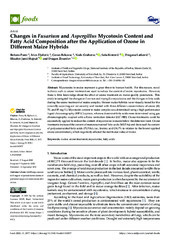Приказ основних података о документу
Changes in Fusarium and Aspergillus Mycotoxin Content and Fatty Acid Composition after the Application of Ozone in Different Maize Hybrids
| dc.creator | Purar, Božana | |
| dc.creator | Đalović, Ivica | |
| dc.creator | Bekavac, Goran | |
| dc.creator | Grahovac, Nada | |
| dc.creator | Krstović, Saša | |
| dc.creator | Latković, Dragana | |
| dc.creator | Janić Hajnal, Elizabet | |
| dc.creator | Živančev, Dragan | |
| dc.date.accessioned | 2022-11-01T08:11:40Z | |
| dc.date.available | 2022-11-01T08:11:40Z | |
| dc.date.issued | 2022 | |
| dc.identifier.issn | 2304-8158 | |
| dc.identifier.uri | http://fiver.ifvcns.rs/handle/123456789/3206 | |
| dc.description.abstract | Mycotoxins in maize represent a great threat to human health. For this reason, novel technics such as ozone treatment are used to reduce the content of maize mycotoxins. However, there is little knowledge about the effect of ozone treatment on maize quality parameters. This study investigated the changes in Fusarium and Aspergillus mycotoxins and the changes in fatty acids during the ozone treatment of maize samples. Sixteen maize hybrids were visually tested for the naturally occurring ear rot severity and treated with three different concentrations of ozone (40, 70, and 85 mg/L). Mycotoxin content in maize samples was determined using a high-performance liquid chromatography (HPLC) system, whereas dominant fatty acids were determined using gas chromatography coupled with a flame ionization detector (GC-FID). Ozone treatments could be successfully applied to reduce the content of mycotoxins in maize below the detection limit. Ozone treatments increased the content of monounsaturated fatty acids (MUFAs) and decreased the content of polyunsaturated fatty acids (PUFAs), i.e., linoleic acid (36.7% in relation to the lowest applied ozone concentration), which negatively affected the nutritional value of maize. | sr |
| dc.language.iso | en | sr |
| dc.publisher | Basel : MDPI | sr |
| dc.relation | info:eu-repo/grantAgreement/MESTD/inst-2020/200032/RS// | sr |
| dc.relation | info:eu-repo/grantAgreement/MESTD/inst-2020/200222/RS// | sr |
| dc.rights | openAccess | sr |
| dc.rights.uri | https://creativecommons.org/licenses/by/4.0/ | |
| dc.source | Foods (Basel) | sr |
| dc.subject | maize | sr |
| dc.subject | ozone | sr |
| dc.subject | ozone treatment | sr |
| dc.subject | mycotoxins | sr |
| dc.subject | fatty acids | sr |
| dc.subject | hybrids | sr |
| dc.subject | Fusarium | sr |
| dc.subject | Aspergillus | sr |
| dc.title | Changes in Fusarium and Aspergillus Mycotoxin Content and Fatty Acid Composition after the Application of Ozone in Different Maize Hybrids | sr |
| dc.type | article | sr |
| dc.rights.license | BY | sr |
| dc.citation.issue | 18 | |
| dc.citation.rank | M21 | |
| dc.citation.spage | 2877 | |
| dc.citation.volume | 11 | |
| dc.description.other | This article is part of the activities of the Center of Excellence for Innovations in Breeding of Climate-Resilient Crops - Climate Crops, Institute of Field and Vegetable Crops, Novi Sad, Serbia. | sr |
| dc.identifier.doi | 10.3390/foods11182877 | |
| dc.identifier.fulltext | http://fiver.ifvcns.rs/bitstream/id/9012/bitstream_9012.pdf | |
| dc.identifier.scopus | 2-s2.0-85138662201 | |
| dc.type.version | publishedVersion | sr |


